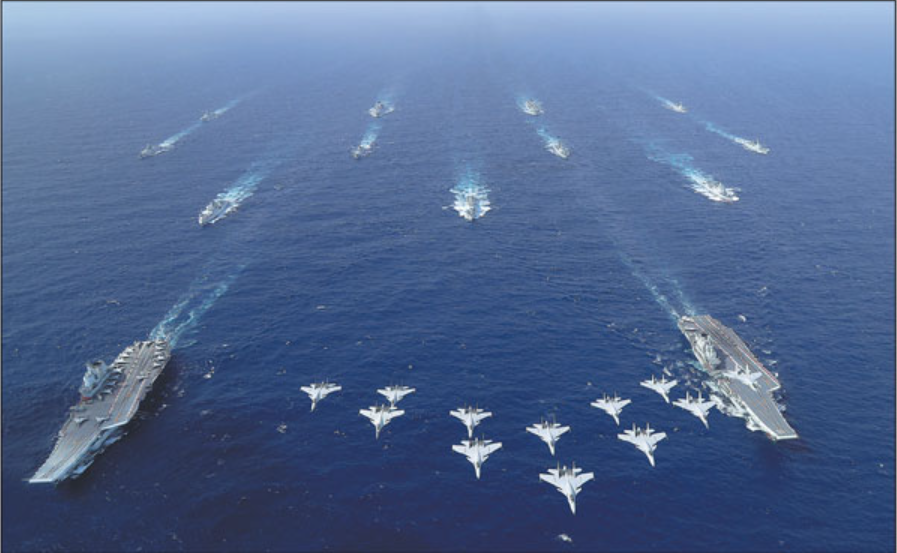Cover photo: The People’s Liberation Army Navy’s CNS Liaoning and CNS Shandong aircraft carrier task groups carry out a joint combat training exercise in the South China Sea in late October. It marked the first time that China’s two carrier strike groups took part in the same exercise. Chen Mengxi/Xinhua. China Daily, November, 1st, 2024.
On September 26th, 2024, the Wall Street Journal released an article alleging that a nuclear-powered submarine would have sunk in the Wuchang shipyard (Wuhan, China) back in June 2024. The submarine, identified by two anonymous US defense officials as the first Zhou-class vessel of its line, would be the newest model of Chinese nuclear-powered submarines. The US defense official’s analysis is based solely on a Maxar satellite image showing floating cranes near the pier. They condemned the Chinese government’s failure to comment on the incident, particularly the absence of any response concerning possible contamination of the surrounding waters. Going beyond just reporting the accident, this article addresses how China struggles to fill the gaps with US technology and its lack of standards for quality control and safety. Moreover, the analysis concludes that this event represents a “major step back” for the People’s Liberation Army Navy (PLA-N).
This event was then re-published in several notorious Western defense presses within two days, without any modification regarding the pieces of information themselves (nuclear-powered new submarine class, analysis of the current state of play of PLA-N, timeline of events). However, J. Michael Dahm and Peter W. Singer set about debunking the information[i], coming to the conclusion not only that the likelihood of this submarine being nuclear-powered is very low, but above all, that the Western media has shown a profound lack of context in their analysis of the development of the PLA-N. The result is that partial or outright false information is being shared. In reality, this event itself tells very little about the so-called backward steps for PLA-N in the future, but it says a lot about Western apprehension of the Chinese expanding fleet. The arguments of their analysis are as follows:
- They reviewed the different steps leading to rumors and misunderstandings;
- They analyzed nuclear-powered submarine properties and compared them with the satellite images;
- They referred to previous announcements by Chinese officials stressing that the only nuclear-capable shipyard was in Huludao on the Northern Bohai Gulf, and then developed the unlikeness of having another nuclear-capable shipyard regarding the Chinese’s current engineering state of play.
Discovering this submarine was a significant event in understanding more about PLA-N submarine strategies and the Chinese maritime environment, but not in the way that Western media misrepresented the story. The actual fleet represents six nuclear-powered ballistic missile submarines, six nuclear-powered attack submarines, and 48 diesel-powered attack submarines. The submarine fleet’s growth is expected to reach about 65 units by 2025 and 80 units by 2035. This development is integrated into the bigger expansion of the PLA-N general fleet, with a total of 370 units including 234 warships – which represents 15 more than the US warship fleet. Every US submarine is nuclear power, however China does not follow a nuclear-centered submarine strategy. This doesn’t mean that they are not capable of building them, but they choose other elements and advantages to match their tailored strategy.
This new type of 039A Yuan-class submarine is between 82 to 85 meters long whereas a nuclear-powered submarine is usually between 90 and 150 meters long. This is one of the elements developed by Singer and Dahm to explain how the sunk submarine is most likely conventional-powered. The main advantage of nuclear-powered submarines is that they can stay for a longer time underwater compared to a conventional submarine. However, building high-performing non-nuclear-powered submarines participates in a stealthier fleet. Moreover, this new type is very likely to be equipped with a Vertical Launching System (VLS). Such a system in their submarine will make possible the launch of anti-ship ballistic missiles, and land attack missiles, compared to the usual torpedos. This game changer significantly increases Chinese deterrence in the region. It is also built with an X-shaped rudder instead of the traditional cross-shaped rudder, which aims to increase agility in shallow waters. A report from September 2023 by the China Maritime Institute (CSMI) also highlights the development of an advanced Aid-Independant Propulsion (AIP) system. Those engineering breakthroughs aim to reduce noise, overall enhancing its combat potential. These technological upgrades all point in the same direction, towards stealth and improved fighting capabilities. These are tailored solutions to identified risks inherent to the geographical feature of the Formosa Strait (Taiwan Strait) and bear witness to the significant improvements made to China’s submarine fleet.
Those improvements participate in ensuring a sea denial strategy. This strategy is defined by the Center for International Maritime Security (CIMSEC) as “excluding other adversaries from utilizing the maritime space in an expected period of time and place of choosing.”[ii] It underlies the notion of domain control within the designated area, which applies here to the South China Sea, the East China Sea, and most of all to the Formosa Strait. This strategy is also qualified as an “Anti-Access/Area-Denial” (A2/AD) Strategy. Fabian-Lucas Romero Meraner[iii] develops how anti-ship, anti-air, and anti-ballistic weapons, submarines, and other naval capabilities in the region “shift the military balance in China’s favor” by limiting deterrence and operational possibilities of the United States and its regional allies to intervene in Taiwan. Sea denial is particularly adapted to maritime chokepoints, as deterrence grows exponentially with anti-ship cruise missiles (ASCMs) that could be launched from submarines to static naval platforms such as ships.
In conclusion, this new sophisticated conventional-powered submarine is a milestone for China’s ambitions in the South China Sea, East China Sea, and Formosa Strait. The PLA-N strategy has enabled China to enhance its non-conventional submarine technology and better respond to local and regional issues. Its advancements in VLS technology have also provided China with a strong deterrence capability. This new element will enable China to expand its fleet and, above all, improve its quality. Western media outlets and governments view nuclear-powered submarines as the future, seeing them as more suitable for their strategic goals. By concentrating on this perspective alone, however, they overlook key aspects of China’s interests in the South China Sea and the strategies China employs to achieve its objectives. It is still difficult to analyze the extent to which Western governments and media misunderstand China’s submarine strategy. However, amid growing tensions, this issue also raises questions of information warfare and influence through media.
Citations
[i] https://www.defenseone.com/ideas/2024/10/chinas-sunken-nuclear-sub-was-likely-nothing-sort/400001/
[ii] https://cimsec.org/the-nature-of-sea-control-and-sea-denial/


Comments are closed